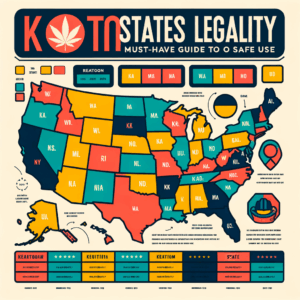
Kratom Ban: Shocking Reasons You Must Know Now!
- Understanding the Kratom Ban: Shocking Reasons You Must Know Now!
- What is Kratom? An Overview
- The Health Risks of Kratom
- Lack of Regulation and Quality Control
- The Controversial Scientific Debate
- Cultural Perspectives on Kratom Use
- The Role of Regulatory Bodies
- Public Awareness and Advocacy
- The Future of Kratom Legislation
- Alternatives to Kratom
- The Personal Impact of Kratom Regulation
- Frequently Asked Questions
- Conclusion
- References
Understanding the Kratom Ban: Shocking Reasons You Must Know Now!

Kratom, a tree native to Southeast Asia, has sparked considerable debate in recent years. While some praise its potential benefits, others highlight its risks. Governments across the globe grapple with this issue, leading to various regulations and outright bans. This post explores the key reasons behind the Kratom ban, helping readers understand this complex situation.
What is Kratom? An Overview
Kratom (Mitragyna speciosa) comes from the leaves of a tropical tree found in countries like Thailand, Indonesia, and Malaysia. Traditionally, people in these regions chewed raw leaves for pain relief and energy. Many users today consume it in different forms, such as capsules, powders, and teas. The active compounds, mitragynine and 7-hydroxymitragynine, interact with opioid receptors, leading to effects that range from pain relief to euphoria.
However, the effects don’t come without concerns. Many experts argue that while Kratom may provide some benefits, it also poses significant health risks. This duality fuels the controversy and has led many jurisdictions to consider bans or restrictions.
The Health Risks of Kratom
One of the most compelling reasons for the Kratom ban centers on health risks. Research highlights various negative effects associated with its use. Regular consumers report experiencing nausea, dizziness, and mood swings. More severe side effects include respiratory depression and seizures.
The opioid-like properties of Kratom raise further concerns. While some argue that it offers a safer alternative to traditional opioids, others see it as a potential gateway to addiction. Emergency rooms across the U.S. have recorded rising incidents involving Kratom, contributing to the skepticism surrounding its safety.
Lack of Regulation and Quality Control
The FDA has expressed concerns about the lack of quality control in Kratom products. Unlike prescription medications, Kratom is often unregulated, meaning users may not know what they’re consuming. Contaminants like heavy metals or other drugs can appear in poorly manufactured products. Reports of deaths linked to Kratom use further underpin the need for regulatory oversight.
Without standardization, users might find varying levels of potency and purity in different products. This inconsistency can lead to unexpected side effects, increasing the urgency for regulatory measures. Thus, many governments are revisiting their stance on Kratom to protect consumers.
The Controversial Scientific Debate
The scientific community remains divided over Kratom’s safety and efficacy. Some studies suggest Kratom holds promise for pain management or addiction recovery. Others challenge these claims, pointing to the potential for misuse, dependency, and withdrawal symptoms. This ongoing debate complicates efforts to regulate or ban Kratom effectively.
Proponents of Kratom emphasize that anecdotal evidence supports its benefits. They argue that many individuals rely on Kratom as a legitimate pain management tool. Yet opponents highlight the need for more comprehensive clinical studies to validate these claims. This tug-of-war contributes significantly to the uncertainty surrounding the substance today.
Cultural Perspectives on Kratom Use
In Southeast Asia, cultural attitudes toward Kratom differ vastly from those in Western countries. Traditionally, locals have used the leaves for centuries. They’re often seen as part of daily life, utilized for medicinal and social purposes. This cultural integration complicates global conversations, as it challenges conventional perceptions of legality and safety.
However, as Western interest in Kratom grows, so do the potential for misuse and misunderstanding. Many users in the West are not familiar with traditional practices. This lack of context can lead to harmful behaviors and outcomes. Thus, cultural perceptions play a vital role in shaping the discourse around the Kratom ban.
The Role of Regulatory Bodies
Regulatory agencies worldwide are either imposing bans or considering regulations on Kratom. The U.S. FDA has taken strong stances against Kratom, issuing warnings to consumers and calling for states to regulate its use. They argue that the potential for addiction and severe health risks warrants action.
Other countries have adopted similar stances. Some nations have outright banned Kratom, while others have implemented strict regulations. This fragmented approach complicates the situation further, as users navigate different legal landscapes. Understanding the reasoning behind these actions helps clarify the stakes involved for government agencies.
Public Awareness and Advocacy
Public advocacy plays a crucial role in shaping the conversation around Kratom. Advocacy groups highlight personal stories of recovery and the positive impact Kratom can have on lives. They urge for better regulations instead of complete bans, emphasizing that responsible usage can coexist with safety measures.
However, misinformation also spreads easily in online communities. Some individuals promote Kratom without acknowledging the potential dangers. This can skew public perceptions and influence policymakers, further complicating the situation. Striking a balance between advocacy and accurate information is essential to foster constructive dialogue.
The Future of Kratom Legislation
The future of Kratom legislation remains uncertain. Ongoing discussions about its medical benefits and health risks will likely influence regulatory decisions. Some jurisdictions are exploring the possibility of regulated access, while others remain firm in their opposition.
Additionally, growing user interest could prompt more research into Kratom’s effects. Increased scientific inquiry may shed light on its benefits and risks, possibly reshaping regulatory approaches. Whether regulations will strike a balance between safety and accessibility remains to be seen.
Alternatives to Kratom
For those seeking pain relief or energy boosts, alternative options exist. Herbal remedies like turmeric, ginger, and boswellia have shown promise in alleviating discomfort. Over-the-counter pain relievers and lifestyle changes can also provide relief.
Yoga and meditation offer holistic approaches for those grappling with stress and anxiety. Regular exercise not only aids physical well-being but enhances mental health too. Exploring these alternatives may help individuals make informed choices about their health and wellness.
The Personal Impact of Kratom Regulation
It’s crucial to understand the potential implications of Kratom regulation on individuals. For some, Kratom serves as a lifeline amid chronic pain or substance withdrawal. A ban could limit access for those who genuinely benefit from its use.
On the other hand, regulatory measures could help protect vulnerable populations from misuse. Understanding the personal stories behind Kratom users reveals the deep emotional connections tied to this substance. Therefore, policymakers must consider the human aspect of the Kratom debate.
Frequently Asked Questions
1. Is Kratom legal in all states?
No, Kratom legality varies by state. Some states have restricted or banned its use.
2. What are the common side effects of Kratom?
Common side effects include nausea, dizziness, mood swings, and, in severe cases, respiratory issues.
3. Can Kratom cause addiction?
Yes, some users may develop a dependency on Kratom, leading to withdrawal symptoms upon cessation.
4. Are there any medical uses for Kratom?
Some studies suggest potential for pain relief and addiction recovery, but more research is needed to confirm these benefits.
5. What should I do if I want to stop using Kratom?
Gradual tapering is often recommended, and consulting a healthcare provider can provide support during the process.
6. What regulations exist for Kratom products?
Regulations vary widely; some states impose strict rules, while others have no regulations at all.
7. Can I find Kratom in health stores?
Yes, Kratom is often available in health stores, but product quality can vary significantly.
8. What’s the stance of the FDA on Kratom?
The FDA recommends against Kratom use, citing safety concerns and potential health risks.
9. Are there reliable resources for studying Kratom?
Yes, several reputable health organizations and research institutions provide information on Kratom’s effects.
10. Is it safe to mix Kratom with other substances?
Mixing Kratom with other substances can significantly increase risks. Always consult a healthcare provider before combining any substances.
Conclusion
The ongoing debate surrounding Kratom highlights a myriad of factors, from health risks to cultural perceptions. As regulations evolve, so does the conversation about safety and accessibility. Awareness of both sides is crucial for informed decision-making. Understanding the complexities of the Kratom ban can help you navigate this contentious issue.
Always stay informed and consult health professionals when considering any substance, and remember, knowledge is power in making informed decisions about your health.
References
1. National Institute on Drug Abuse (NIDA)
2. Food and Drug Administration (FDA)
3. American Kratom Association
4. National Center for Complementary and Integrative Health (NCCIH)
5. Mayo Clinic


